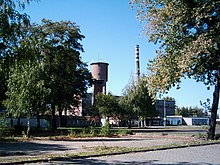Kopalnia Węgla Kamiennego Pierwszego Maja
The Pierwszego Maja Mine ( Kopalnia Węgla Kamiennego Pierwszego Maja , May 1st Mine) is a disused coal mine in Wodzisław Śląski , Poland.
history
Because numerous deposits of fat coal were found in the city triangle Rybnik - Jastrzemb - Loslau / Wodzisław Śląski and, as a result of detailed explorations, seam deposits amounting to 1 billion t of coking coal (as of 1958) were found, the Polish state economy planned to build numerous mines in this area .
The Council of Ministers of the People's Republic of Poland therefore decided in 1950 to build a mine in the southern tip of the Chwałowice Mulde. The mine between the districts and Wilchwy Mszana with a Berechtsame should km² of 145.04 multiple seams with a thickness of about 1 m mine , was realized in the years 1952 to 1960 and put into operation on May 1, 1960th The problem of a high methane content in the coal seams was already apparent during tunneling when it came during drilling to two inflammation. The fact that the construction of the mine took eight years is, among other things. a. This can be attributed to the fact that the miners' food supply was inadequate, the compressed air supply inadequate and too few trucks were available at this time.
A total of four shafts were sunk , I with double conveyance for rope travel and material transport, II for ski conveyance through a tower conveyor system and the weather shafts III and IV in "Mszana" and "Wodzisław".
Until December 1960, the colliery was called Mszana , since January 1st, 1961 it has been called 1 Maja / 1. May .
Although the production increased from 4,200 tonnes per day in 1965 to 6,000 tonnes per day in 1970, the operating result was inadequate. For this reason, in 1969 the production was switched from the 250 m level to hydrotransport and from 1970 to 1972 Shaft IV was equipped with a conveyor system and processing .
From 1973, three were coal plow type "Westfalia-Luenen" used to the degradation in coal seams under 35 ° come to mechanize. In 1977 the hydrotransport of coal was stopped again; Nevertheless, the annual production could be increased to 2.6 million tons in 1981. During these years numerous other weather shafts were sunk, so that in 1984 the mine had a total of nine shafts.
From 1991 the mine was in the red despite further modernizations, so that in 1995 the merger of the mines 1 Maja and Marcel under the name Marcel in "Wodzislaw Slaski" was ordered. On December 9, 2001, the mine was officially closed; many buildings were destroyed and the shafts filled . Numerous underground structures were preserved so that they could be used again if necessary.
Funding figures
- 1970: 2.42 million t
- 1979: 2.73 million t
literature
- Jerzy Jaros. Słownik historyczny kopalń węgla na ziemiach polskich . Katowice: Śląski Instytut Naukowy, 1984. ISBN 83-00-00648-6 .
- Kurt Koenig. Coal mining in Upper Silesia from 1945–1955 . Scientific contributions to the history and regional studies of Eastern Central Europe. Published by the Johann Gottfried Herder Institute. Marburg 1958.
Individual evidence
- ↑ King: The coal mining. P. 61
- ↑ http://www.sitg.rybnik.pl/1/index.php?historia-kwk-1-maja-,29 (last accessed on February 16, 2016)
Coordinates: 49 ° 58 ′ 38.2 " N , 18 ° 29 ′ 49.3" E
